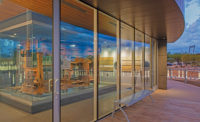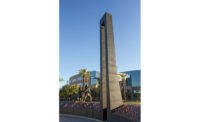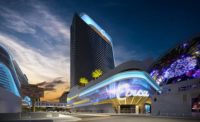A central belief of the tribes that make up Arizona’s Salt River Pima Maricopa Indian Community is the “Man in the Maze,” which uses a labyrinth to symbolize the journey through life.
So it’s appropriate that a largely undeveloped site on the community’s 62,600 acres near Scottsdale should be the start of a journey through a decade-long development project called Akimel 7. The anticipated build-out will total 12 million sq ft of entertainment venues, businesses, sports facilities and other attractions in a technology-rich, resource-sustainable environment, according to the development’s backers.
At least that’s the vision of David Fordon, CEO and general manager of the Solanna Group, a Scottsdale-based, Native American-family-owned real estate investment firm that is developing Akimel 7. The initiative is a joint venture with CamCo Commercial Inc., a global commercial investment and development company headed by entrepreneur and former professional football player Cameron Colvin.
Akimel 7’s goal, says Fordon, is to create “a place of distinction for our community, a smart city and a must-see destination” in the greater Phoenix Valley, if not the entire U.S.
Although the Akimel 7 site already hosts a temporary stadium that has been used by Phoenix’s minor-league soccer team, the development’s first official steps began in late January when installation of water supply lines got underway. Vertical construction is slated to ramp up on the development’s initial 220-acre phase later this year, although the specific components and many other details of the plan remain confidential. The project’s backers have promised that Akimel 7 will comprise as many as 40 separate projects, most of which will be “one-of-a-kind uses.”
Those include a sports district centered around a multipurpose stadium, multiple field and court-sport venues and fully equipped sports medicine and rehabilitation support facilities, with an eye toward potentially luring professional teams. Akimel 7’s entertainment options could range from multimedia production studios to a virtual-reality theme park.
Hotels, upscale retail, restaurants, specialized shopping, offices, amphitheaters and an international school are also part of the plan, which includes an emerging-technology zone for robotics and nanotech and an international business trade zone with import and export capabilities.
Although tenants for these facilities have yet to be announced, Fordon says Akimel 7’s location in a qualified opportunity zone “gives investors a competitive advantage.”
Concentrating development in specific areas will afford expansive open space for use as parkland, recreation, outdoor shows and other events, he says.
Sustainability Goals
Equally important to the project’s vision, Fordon adds, is the effort to reflect the Native American values of reverence for the land that the Pima and Maricopa tribes have occupied for more than 4,000 years as well as respect for the environment and due consideration for the future. Those goals are reflected in Akimel 7’s name, which combines the Pima word for “water people” and the number seven, representing the Native American philosophy of thinking seven generations ahead.
For that reason, the project aims for a zero-carbon environment supported by sustainable infrastructure. Akimel 7’s developers plan to implement an all-electric automated personal transport grid similar to that in the Masdar City development in Abu Dhabi. Also planned are a 25-MW solar power plant, a closed-loop, complete water-recycling system and a thermal energy-capture system.
“We are planning innovative building methodologies that challenge the problems with permanence.”
– David Fordon, CEO, Solanna Group
Anticipating the continued growth of electric and other alternative fuel cars and trucks, Fordon says conventional gasoline-fueled vehicles will be concentrated into parking structures equipped with special air-scrubbing technology.
Construction of Akimel 7’s many facilities promises to be equally unconventional.
“We are planning innovative building methodologies that challenge the problems with permanence,” Fordon says. One element will be wide use of structural stratiform modules (SSMs), prefabricated tetrahedral space frame structures used to form artificial land terraces and multiple modular building spaces.
Coupled with robotic construction technology, SSMs “will enable us to easily assemble, disassemble, expand and change the configuration of any building over time as markets change without having to tear down and rebuild,” Fordon adds.
He says that every step of Akimel 7’s evolution will be closely coordinated with the Salt River Pima Maricopa Indian Community. “We will be establishing the development as a special improvement overlay district that sets quality standards for buildings, fostering an architecturally innovative ‘not before seen’ look and feel. The district also will provide logistical support for construction timing and mobilization orchestration, establish and operate a district-wide road and utility easement network and manage all open space and common areas,” he says.
First Steps
Those large ambitions will come with an equally large price tag—as much as $4 billion, according to Fordon, half of which will be required for securing leases on adjacent land, infrastructure and vertical construction and the solar-powered system.
But there is evidence that if Akimel 7 is built, people will come. The River Pima Maricopa Indian Community already operates a number of commercial enterprises—including a resort and casino, a golf course and a retail complex—north of the planned development.
“We will be establishing the development as a special improvement overlay district ...”
– David Fordon, CEO, Solanna Group
Near-term plans call for build-out of approximately 500,000 sq ft along the Akimel 7 development’s west side, Fordon says, with construction of the remaining sections getting underway as early as 2023, after entitlement and infrastructure analysis are complete.
Fordon understands that any development of this size and scale can be fraught with unknowns and more than a few doubts. That’s why, he says, cooperation is essential with the community’s government and neighboring member landowners who support the developers’ vision.
“Obviously, the potential for positive economic returns for the landowners and the community is enormous, and we already have significant encouragement from the community and those many families who want to help realize the Akimel 7 vision,” he says. “Landowner alignment, therefore, as we continue to unify the various land pieces under a single integrated master plan, is our number-one priority.”
And while the long journey of Akimel 7 is only beginning, with many day-to-day, phase-to-phase challenges to come, Fordon says it’s important to remain focused not only on the long-term vision but also on what made the opportunity possible.
“We feel we can make an enduring statement of how proud we are of our ancestors who stood tall over the years to protect the land so its value could be preserved for future generations—meaning our generation will do the same,” he says.









